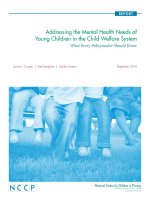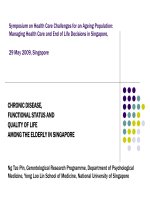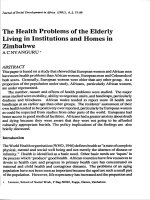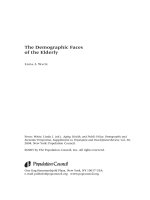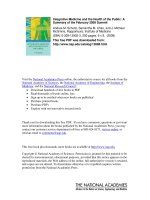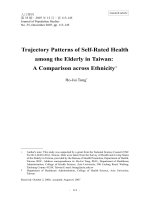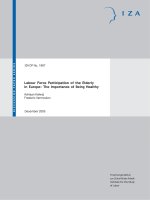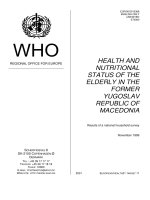Functional Health Status of the Elderly in Taiwan docx
Bạn đang xem bản rút gọn của tài liệu. Xem và tải ngay bản đầy đủ của tài liệu tại đây (542.17 KB, 9 trang )
Healthy Aging & Clinical Care in the Elderly 2010:2 9–17
This article is available from .
© the author(s), publisher and licensee Libertas Academica Ltd.
This is an open access article. Unrestricted non-commercial use is permitted provided the original work is properly cited.
OPEN ACCESS
Full open access to this and
thousands of other papers at
.
Healthy Aging & Clinical Care in the Elderly
ORIGINAL RESEARCH
Healthy Aging & Clinical Care in the Elderly 2010:2 9
Functional Health Status of the Elderly in Taiwan
Tina Wu
Clinical Counselling and Consulting Group Vancouver, Canada. Corresponding author email:
Abstract
Purpose: The purpose of the study is to understand the functional health status of the elderly in Taiwan by using the Chinese version of
Minimum Data Set—Home Care (MDS-HC) as a health assessment measurement.
Design and methods: Study participants were randomly recruited from southern Taiwan through a two stage strata (Urban/Rural and
County/Township) sampling method. The nalized valid study participants were 402. In-person interviewers (n = 12) for this project
were professional nurses who were required to attend three MDS training sessions. The average length of data collection (interview-
ing) was 40 minutes. Data were assessed for inter-rater reliability. Multi-functional information from the following were gathered from
participants for analysis: cognitive patterns; communication/hearing; vision; mood and behavior patterns; social functioning; informal
support services; physical functioning; continence; disease diagnoses; health conditions and preventive health measures; nutrition/
hydration status; dental status; skin condition; environmental assessment; service utilization; and medication information.
Results: 82% of the participants rated themselves as healthy and functional older community residents. Subjectively, they considered
themselves having no problem with daily functional activities/independence; however, data show the elderly are in need of the follow-
ing community services: preventive health (99.8%); psychotropics (94.8%); visual function (59.2%); social function (49.8%); health
promotion (36.1%); and reduction of formal services (31.3%). Additionally, the Client Assessment Protocol (CAP) triggers several
potential problems.
Implications: Findings support that specic services should be made available to community-dwelling older adults in Taiwan in order
to promote their health status.
Keywords: health status, health needs, elderly, CAP triggers
Wu
10 Healthy Aging & Clinical Care in the Elderly 2010:2
Introduction
The aim of this paper is to discover the functional health
status of the elderly in Taiwan through the Minimum
Data Set—Home Care (MDS-HC) assessment tool.
The study of aging process is an ancient subject but
has recently become a very popular science. Although
complex, it should be examined from a systematic
approach. It can be from emotional, physiological, eco-
nomic, social, cognitive, or psychological perspectives.
Each viewpoint adds a dimension to the broader under-
standing of what it means to age personally, socially,
and globally. Until now, researchers use “successful
aging” as the optimal outcome for aging successfully.
1
Empirically, they stated “studies on successful aging
can be divided into two components: clinical standards
by which successful aging is measured and psychoso-
cial theories exploring the process of adjustment to the
aging process. Some studies have combined elements
from both components when examining successful
aging.” Theoretically, Rowe and Kahn
2,3
differentiated
“successful aging” from “usual aging”. Their deni-
tion of successful aging described elderly individuals
who have a low level of disease or disability, a high
cognitive and physical functioning capacity, and an
active engagement with life.
Measures of functional status have been widely
used in clinical studies of successful aging. Histori-
cally, the primary focus has been functional health
status, economic issues, and family support issues
4,5
Also, a major focus in aging research is to discover
the causal relationship between psychological (or
subjective) well being and health status.
6,7
Since psy-
chological well being is a subjective term, many dif-
ferent denitions and measurement tools have been
designed to assess subjective well-being. Generally
speaking, well-being means feeling good, or having
good mental health; it is a personal evaluation based
on how the respondent feels, not an evaluation based
on external criteria such as visits to mental hospi-
tals or psychologists’ clinical evaluations. However,
research has found, for the elderly, physical and/or
mental health outcome is strongly linked to one’s psy-
chological well being.
8
Also, research has consistently
demonstrated that individuals in poor health are less
satised with their lives than those in good health.
9
In addition, health has also been found to inuence
people’s projection with future life satisfaction and
their changes in life satisfaction over time.
10,11
Quality of life (QOL) is another reliable evaluation
concept in relation to older people’s health and illness.
QOL is dened as the combination of an individual’s
functional health, feelings of competence, indepen-
dence in Activities of Daily Living (ADL)/ Instrumental
Activities of Daily Living (IADL), and satisfaction with
one’s social circumstances.
12
Ideally, the study of health
status for the elderly should include both subjective and
objective health outcome concepts. Perceived health
status or self-reported health status is the subjective
health outcome (or health problems) reported by the
respondent. It is the best single predictor of life satis-
faction for the older population since it is more strongly
related to life satisfaction than other factors identied by
researchers.
13,14
In addition, researchers have found that
objective evaluated health status information provided
by physicians can serve as a cross-validation source to
ensure the reliability of the subjective health informa-
tion offered by their patients.
13,15
There are several measurements available for
measuring functional health status of seniors. Older
American Resources and Services—Multidimensional
Functional Assessment Questionnaire;
16
ADL and
IADL; Short Form 36 items health survey (SF-36)
and Short Form 12 items health survey (SF-12); the
Mini Mental State Examination (MMSE), the Life
Satisfaction Index A (LSIA); Cognitive Performance
Scale (CPS); Health Utilities Index—mark 2 (HUI2);
Shanghai Successful Aging Project Questionnaire;
17
the Brief Risk Identication of Geriatric Health Tool
(BRIGHT) questionnaire;
18
and Minimum Data Set
for Home Care (MDS-HC).
19
The rst two scales
rely heavily on a doctor’s accurate diagnosis and a
patient’s honest disclosure of his/her health condi-
tions. As to the latter two scales (i.e. ADL/IASL and
SFU12/36), they are more suitable for older people
living in aggregate compound.
20
The MHS-HC is
another assessment tool designed for community
dwelling seniors. Although Chi
21
concluded that the
function of MDS-HC in case nding or screening is
limited for Hong Kong primary medical care setting,
in this study, MDS-HC is chosen due to its compre-
hensiveness in geriatric assessment.
In Taiwan, the percentage of people over
age 65 in 2008 was 10.4% (DGBAS, Bureau of
Statistics, 2009). Statistically, the growth rate of this
population will accelerate to a level of 3.0% annually
from 2020–2025.
22
The growing of the aging population
Functional health status of the elderly in Taiwan
Healthy Aging & Clinical Care in the Elderly 2010:2 11
will require equivalent increase in health care services.
The National Health Insurance in Taiwan was imple-
mented in 1995. As in other developed countries, such
as the National Health Service in England, Medicare/
Medicaid in the United States, and the Medical Ser-
vices Plan (MSP) of Canada, all provide programs or
implement policies to assist their senior citizens to
cope with health related issues. According to ndings
of 2005 Taiwanese National Census,
23
33.4% of the
population over age 65 rated their health “excellent”
subjectively; however, a responsive health services for
the years to come maybe necessary for the expected
growing aging population.
Methods
Participants and setting
Study participants were randomly selected from
southern Taiwan by using a two-stage strata (urban/
rural and Lin/Lee) sampling method. A roster of the
elderly aged 65 and over was provided by the Ministry
of Household Registry. Participants were randomly
selected for interview. Face-to-face trained interview-
ers (n = 12) for this project were professional nurses
who were required to attend three MDS-HC trainer’s
sessions before the actual data collection. The train-
ing procedure was to ensure international standard-
ized MDS-HC required by the interRAI Group. Data
collection period lasted for 3 months. On average, the
length of each individual interview was 40 minutes.
Study sample size and response rate
Based on 95% condence level, the intended design
for sample size was 520; however, after eld data
collection, 405 completed the questionnaire. Of the
405 questionnaires, 3 of them were determined by the
research team as invalid for further analysis. The nal
response rate for the project was 78%.
Research Procedure
Step 1: Obtained study approval from a local univer-
sity Research Ethics Review Committee.
Step 2: Identied study population and selected
research participants.
Step 3: Standardized MDS-HC training sessions
for 12 interviewers before data collection.
Step 4: Questionnaire translation and validation.
Minimum Data Set for Home Care (MDS-HC)
measurement questionnaire was translated forward
and then backward into Chinese version by 3/3
bi-lingual Social Science/Social Work professionals
to test its cultural adaptability and compatibility with
Taiwanese senior population.
Step 5: Collected consent forms from all partici-
pating individuals. Instrument testing with 10 pre-test
eld interviews. Pre-test interviews were conducted
after Step 2 was completed to discover the needs for
necessary questionnaire modication.
Step 6: Data Collection.
Step 7: Statistical Analysis. The current research
involved uni-variate and bi-variate analytical
procedures.
Research Instruments
The MDS-HC questionnaire was chosen as the instru-
ment for the study due to its comprehensiveness in
functional health assessment and its capability in
nding unmet needs in community-dwelling seniors.
The MDS-HC assessment items included measures
in the following areas: personal information, cogni-
tive patterns; communication/hearing; vision; mood
and behavior patterns; social functioning; informal
support services; physical functioning; continence;
disease diagnoses; health conditions and preventive
health measures; nutrition/hydration status; dental
status; skin condition; environmental assessment; ser-
vice utilization; and medication information. Asses-
sors for MDS-HC are required to have professional
medical/nursing training and practice.
It was designed by interRAI Group as a standard-
ized geriatric assessment tool used by international
collaborators and researchers.
24,25
It is designed to be
administered by trained assessors to ensure its effec-
tiveness and accuracy. In the United States, it is one
of the tools accredited by the Department of Health.
The instrument covers contact information, overview
of comprehensive assessments. Repetitive use of
the instrument can detect participants service needs
change over time.
The instrument also offers 30 different Client
Assessment Protocols (CAPs) which can be ‘triggered’
as part of the assessment process. The CAPs refer to
areas of concern which may require further investi-
gation, internal/external referral and consideration as
part of the individual‘s care plan. In sum, the collec-
tion of CAPs information is to support professional
judgment. Together, there are 3 major categories in
Wu
12 Healthy Aging & Clinical Care in the Elderly 2010:2
CAPs: (1) Functional Performance; (2) Sensory Per-
formance; and (3) Mental Health. Three CAPs catego-
ries and their subsequent measurement areas are listed
in Table 1.
The Version 2.0 MDS-HC instrument was trans-
lated from the English to Chinese using backward
and forward methods
26
to verify the accuracy of the
translation process. Three bi-lingual (Chinese and
English) Social Science professionals provided the
forward translation. A nal forwarded translation was
nalized when the team reached their consensus with
discrepancies occurred in the translation process.
Another 3 Social Work professionals then translated
the Chinese version back to English. Final compari-
sons were made between the translated version and
the original version to determine the accuracy of the
Chinese version.
Data Processing and Statistical
Analysis
Functional health status data is presented to support
the purpose of the study. Analyses of participants’
demographic background, current and potential health
problems, and CAPs calculations are conducted to
determine the health needs of the participants.
Descriptive and univariate analyses were used to
determine the status of older adults participated in the
study. Characteristics of respondents were presented
according to the coding system in the questionnaire.
Data were re-grouped into “low severity”, “medium
severity”, and “high severity” to differentiate the
health needs of the participants. All statistical analy-
ses were performed using SPSS statistical software,
version 15.
Results
Distributions of participants’
characteristics
Table 2 shows the background characteristics of
the respondents. The mean age of the respondents
was 71.5 years old with standard deviation [SD] of
5.3 years. Among the participants, 55.5% were male;
71.9% were married; 36.3% had elementary level
formal education and 36.3% had no education, and
21.6% had a secondary school or higher education.
Although Mandarin is the ofcial language of Taiwan;
Taiwanese dialect was the language spoken at home
for most of the 65.4% respondents. For 90.0% of the
participants living at home, they did not need for-
mal care services for their daily routines. For living
arrangement, those who living at home, 46.8% were
living with spouse and others (non-children); how-
ever, 49.0% of the participants received their source
of income from their children no matter what was
their living arrangement. As to taking medication in
the past 7 days, 47.3% of them were medication free.
Table 1. Three CAPs categories and their subsequent measurement areas.
(1) Functional performance (2) Sensory performance (3) Mental health
ADL rehabilitation potential
Communication disorders Alcohol abuse
Instrumental activities of daily living Visual function Cognition
Health promotion Continence Behavior
Instructional risk Bowel movement Depression and anxiety
Health problems Urinary incontinence
and indwelling catheter
Elder abuse
Cardio respiratory Social function service oversight
Dehydration Compliance with treatment
Falls Risk of breakdown of informal support
Nutrition Medication management
Oral health Palliative care
Pain Immunization and screening
Pressure ulcers Psychotropic drugs
Skin and foot problems Reduction in formal services possible
Environment assessment
Functional health status of the elderly in Taiwan
Healthy Aging & Clinical Care in the Elderly 2010:2 13
Table 2. Distributions of participants’ characteristics.
Variables N (%) Mean/
median
(SD)
Age group
65–74
75–84
85 and over
402 (100.0)
304 (75.6)
88 (21.9)
10 (2.5)
71.5 (5.3)
Gender
Male
Female
400 (100.0)
222 (55.5)
178 (44.5)
1 (0.5)
Marital status
Never married
Married
Widowed
Other
402 (100.0)
6 (1.5)
289 (71.9)
101 (25.1)
6(1.5)
2 (0.5)
Language spoken at home
Mandarin
Taiwanese
Haka
Other
402 (100.0)
71 (17.7)
263 (65.4)
67 (16.7)
1 (0.2)
2 (0.6)
Education
Literate
Literate (self-taught)
Elementary school
Junior high school
Senior high school
College and above
402 (100.0)
146 (36.3)
20 (5.0)
149 (37.1)
33 (8.2)
45 (11.2)
9 (2.2)
3 (1.4)
Physical assistance
Home(no aide)
Home with aide
Retirement apt
Other
402 (100.0)
362 (90.0)
31 (7.7)
3 (0.7)
6 (1.5)
1 (0.6)
Living arrangement
Home (alone)
Home with spouse only
Home (spouse and others)
Home with children
Home with non-children
Other
402(100.0)
31 (7.7)
90 (22.4)
188 (46.8)
86 (21.4)
6 (1.5)
1 (0.2)
3 (0.9)
Major source of income
From self
From pension
From spouse
From rental
From investment
From savings
From children’s support
From social assistance
Other
402 (100.0)
40 (10.0)
64 (15.9)
10 (2.5)
4 (1.0)
2 (0.5)
14 (3.5)
197 (49.0)
62 (15.4)
9 (2.2)
7 (2.7)
Medical history 402 (100.0)
(Refers to receiving
medical services 5 years
prior to referral)
Yes
No
212 (52.7)
190 (47.3)
2 (1.8)
Overall, 82% of the respondents reported their health
as positive and healthy.
Health status of the elderly in Taiwan
Information of the health status of the elderly in Taiwan
is summarized in Table 3. In Table 3, 16 health condi-
tions are listed based on their level of severity. Each
health condition is classied into 3 levels: low sever-
ity, medium severity, high severity. The classication is
to differentiate participants’ health needs. The lower the
severity level is, the lesser the immediate health need is.
Percentages in “medium severity” indicate areas of health
needs: “vision” (29.1%), “social functioning” (19.9%),
“informal supports” (27.2%), “dental” (98.0%), and
“environmental risks” (15.7%). When re-arranging the
percentages, the top health need is for “dental” services,
followed by “vision” services, “informal supports” ser-
vices, “social functioning”, and “environmental risks”
prevention services. As to other listed health conditions,
percentages in Table 3 show minimum health needs
from the participants. Problems triggered by CAPs cal-
culation will be discussed in Chart I and Chart II.
Table 3. Health status of the elderly in Taiwan.
Health status (range) Low
severity
(%)*
Medium
severity
(%)*
High
severity
(%)*
Cognitive (0–6) 89.8 8.4 1.7
Communication/hearing
(0–9)
88.3 9.9 1.7
Vision (0–6) 70.7 29.1 0.2
Mood and behavior (0–3) 98.0 1.4 0.4
Social functioning (0–8) 77.2 19.9 2.9
Informal supports (4–25) 72.8 27.2 0.0
IADL (0–21) 91.0 9.0 0.0
ADL (1–41) 96.9 2.5 0.0
Continence (1–10) 91.8 8.0 0.2
Potential health risks
(4–26)
100.0 0.0 0.0
Nutrition/hydration (0–8) 97.3 2.5 0.2
Dental (0–2) 0.2 98.0 1.7
Skin condition (0–16) 95.8 3.2 1.0
Environmental risks (0–5) 82.6 15.7 1.7
Formal service utilization
(0–4)
97.0 2.0 1.0
# of medications (0–4) 100.0 0.0 0.0
Note: *Some numbers do not add up to 100.0 due to the calculation
accuracy to 2nd fractional digits, i.e. 0.00 in the original formula.
Wu
14 Healthy Aging & Clinical Care in the Elderly 2010:2
4.2
21.1
19.9
0
99.8
94.8
31.3
28.1
2
10
36.1
0.5
23.4
59.2
2.7
18.2
1.5
0.7
3.2
49.8
9
8.7
9
10.9
18.4
10
21.1
34.8
18.7
8.7
8
Adherence
Brittle support
Medication mgt
Palliative care
Preventive health
Psychotropics
Reduction service
Environ assessment
ADL rehab
IADL
Health promotion
Institutional risk
Communication
Visual function
Alcohol abuse
Cognition
Behavior
Depression
Elder abuse
Social function
Pressure ulcer
Cardio-Respiratory
Pressure ulcer
Dehydration
Falls
Nutrition
Oral health
Pain
Skin & foot
Bowel mgt
Urinary incont
0
20
40
60
80
100
%
Health needs
Chart I. Percentage distribution of cap triggered potential health needs.
Note: ADL stands for “Activity of Daily Living”; Environ Assessment stands for “Environmental Assessment”.
Client Assessment Protocol (CAP)
triggered health needs
Further analysis using CAPs calculation method,
31 health related issues were included in the formula
for the purpose of nding participants’ potential health
needs. In Chart I, the results show us percentages of
CAPs triggered health conditions ranged from 99.8%
to 0.0%. The higher the percentage is, the more urgent
of their health need is in that specic health condition.
The top 10 CAPs triggered potential health conditions
as follows: 99.8% of preventive health (i.e. 99.8% of
the respondents are in need of preventive health), fol-
lowed by 94.8% of potential psychotropic problems
(i.e. depression and dementia related issues), 59.2%
of vision care, 49.8% of social functions, 36.1% of
health promotion, 34.8% of pain management, 31.1%
service reduction, 28.1% of environment assessment,
23.4% of potential communication problem, and
21.1% of potential brittle support.
The total number of potential health needs of sur-
veyed participants identied by CAPs is shown in
Chart II. The higher the total number is, the more health
issues the participants have. The range of the total
number of health needs in Chart II is from 1 to19. The
result indicates 13.4% of participants have four CAP
triggered potential health issues; followed by 12.4%
of three potential health issues; 12.2% of two potential
problems; 10.4% of six health problems; and 10.0% of
seven health problems identied. The majority of the
participants have total number of health needs of four
or less than four potential health problems identied.
Discussion and Policy Implication
The primary objective of the study is to unveil the
functional health status of the elderly in Taiwan. All
together, 402 randomly selected senior participants
were interviewed and assessed for the study. The
author’s rationale is that the current study may be
used for policy planning, implementation, and ser-
vice enhancement purposes.
Researchers and practitioners in Taiwan have been
requesting a system of effective service delivery;
however, provision of senior services is still in initia-
tives stage. This situation could have been caused by
lacking baseline health status data, therefore, having
information available for policy makers is critical.
For mature adults, a higher level of functional
health status indicates their successful aging process.
It is a combination of physical, psychological, and
social conditions.
1
In addition, the status reects a
combination of measurable indicators that reect all
levels of their daily functioning. The tool used in the
Functional health status of the elderly in Taiwan
Healthy Aging & Clinical Care in the Elderly 2010:2 15
0
12.2
12.4
13.4
8.7
10.4
10
6.7
4.2
5.2
4
5
2.2
1
1.2
2
0.5
0.2
0.5
0
1
2
4
6
8
10
12
14
16
Total number of health needs
2345 6 78910111213 14 15 16 17 18 19
%
Chart II. Percentage distribution of total number of cap triggered health needs.
current study is MDS-HC to measure the participants’
cognition, communication/hearing, vision, mood and
behavior, social functioning, IADL/ADL, nutrition,
dental, skin, health risks, formal and informal service
needs, and medication intake.
The results of this study reveal that there is a gap
between subjective (self-reported) health status and
objective (MDS-HC assessment tool) health status of
the participants.
1. In the study, 82% of the respondents’ subjectively
reported their health status as positive and healthy.
2. Objective health status of the participants measured
by MDS assessment tool indicates their needs in the
following: vision care, social functioning, informal
support, dental, and at risk of environmental haz-
ards at home. As to the total number of potential
health needs triggered by CAP, the majority of the
participants have a total number of four or less than
four identied potential health needs.
Which health status rating is a more accurate rep-
resentation of the true state of the elderly in Taiwan?
Although longitudinal studies are recommended for
the future to uncover details of the gap in between
objective and subjective health status, the literature
suggests measurement preferences, cultural norm
factors, participants’ lacking exposure to accessible
and available services, and little health prevention
education offered to seniors in Taiwan may play a key
role in the ndings.
Based on Dollinger and Malmquist,
27
an ideal
functional health status measurement needs to a mea-
surement consists of both subjective and objective mea-
sures. Although in their study, objective evaluations
were more reliable than subjective evaluations, subjec-
tive ratings were necessary for purpose of comparison.
Sievers
28
indicates patients’ symptoms and perceived
health is in part an independent construct, not merely
reecting their objective measures. Subjective measures
should therefore be regularly documented in patients as
a patient-oriented indicator for treatment success.
Cultural norms and ethnicity may be a contrib-
uting factor to the gap. There is limited research on
Asian seniors and preventive medicine in the litera-
ture; however, researchers found evidence to sup-
port its unpopularity in the culture.
29–31
Reasons for
its unpopularity include cultural (aging is a normal
process) and medical linguistic factors (i.e. medical
terminologies), a lack of knowledge about preventive
tests, feelings of embarrassment during medical tests,
and the low priority of health screening when com-
paring with other commitments.
Furthermore, the author examined issues related
to representativeness of participants in the current
research. Study participants were selected randomly
in the southern region of Taiwan based on two stage
Wu
16 Healthy Aging & Clinical Care in the Elderly 2010:2
strata sampling method; however, can one generalize
the ndings to the entire Taiwanese elderly popula-
tion? Information in Table 4 examines and compares
the distribution of the two populations. For all age
groups, the range for differences are between (-)4.1%
and (+)15.3%, indicating over-representation of age
group 65–74 by 15.3%, under-representation of age
group 75–84 by 11.2%, and under-representation by
4.1% of the 85 and above age group. Although the
differences are not statistically signicant (2-tailed
t-test: 0.07; 0.12; 0.27), the generalizability principal
of the ndings should be applied with caution.
As to the mental health issues discovered in Chart 1,
it could be embedded in the cultural heritage of the
population. In traditional Taiwanese/Chinese cul-
ture, the social norms usually do not support verbal
expression of explicit needs. Direct communication
of personal desires is not part of the traditional inter-
nalization and socialization processes for Taiwanese
seniors. Instead, Taiwanese elders tend to exhibit
psychosomatic symptoms such as stomach pains and
headaches during time of their physical as well as
mental health problems. If caregivers or family mem-
bers are less sensitive to the symptoms and treat them
as “normal aging process”, the possibility of early
detection and treatment is low. The nding suggests
public education on prevention and early treatment
maybe a top priority service for Taiwanese seniors.
In conclusion, ndings from this study support
specic preventive and daily functioning services
needed to be made available to community-dwelling
seniors in Taiwan. By doing so, it would increase both
subjective and objective health status of the elderly
population and consequently would lead to their qual-
ity of life in the community as well.
Disclosure
This manuscript has been read and approved by the
author. This paper is unique and is not under con-
sideration by any other publication and has not been
published elsewhere. The author and peer reviewers
of this paper report no conicts of interest. The author
conrms that they have permission to reproduce any
copyrighted material.
References
1. Tate RB, Lah L, et al. “Denition of successful aging by elderly Canadian
males: the Manitoba Follow-up Study”. Gerontologist. 2003;43(5):735–44.
2. Rowe JW, Kahn RI. “Human aging: Usual and successful.” Science.
1987;237:143–9.
3. Rowe JW, Kahn RI. “Successful aging”, Dell Publishing, New York,
1998;36–52.
4. Wykle M, Kahana E, Kowal J. “Stress and health”, Springer Publishing
Company, New York. 1992
5. Stahl SM, Mignon L, Meyer JM. “Which comes rst: Atypical antipsy-
chotic treatment or cardio-metabolic risk?”. Acta Psychiatric Scand. 2009
Mar 119(3):171–9.
6. Chi I, Wong SF. “Respite service for the elderly in Hong Kong: Evaluation
of a pilot project”. Journal of Gerontological Social Work. 1994;22(3–4),
201–10:(10).
7. Hillier S, Barrow GM. “Aging, the individual, and society”, Wadsworth
Publishing, Belmont, California, 7th edition, (428p). 1999
8. Ryff C, Marshall VW, editors, “Self and society in aging processes”,
Springer Publishing, New York, NY, (502p). 1996
9. Conrad P, Kern R. “Sociology of health and illness: Critical perspectives”.
St. Martin’s press, Inc., 1990;258–66.
10. Mroczek DK, Spiro A III. “Modeling intra-individual change in personal-
ity traits: Findings from the Normative Aging Study”, Journal of Geron-
tology: Series B, Psychological Science and Social Sciences. 2003;58B(3),
153–65:(13).
11. Bourque P, Pushkar D, Boneville L, Beland F. “Contextual effects on life
satisfaction of older men and women”. Canadian Journal on Aging, Spring.
2005;24(1):31–45.
12. Hooyman N, Kiyak HA. “Social gerontology—A multidisciplinary per-
spective”, Pearson Education, Inc., Boston. 2008
13. Mannell R. “Leisure experience and satisfaction”, in Jackson EL. Burton TL
editors, “Leisure studies: Prospects for the twenty-rst century”, Venture Pub-
lishing, State College, PA. 1999
14. Gangbe M, Ducharme F. “Concepts and models of aging well”. Medical
Science (Paris). 2006;22(3):297–300.
15. Depp CA, Jeste DV. “Denitions and predictors of successful aging: A com-
prehensive review of larger quantitative studies.” Am J Geriatr Psychiatry.
2006;14(1):6–20.
16. OARS, Center for the Study of Aging and Human Development, 1975.
17. Li C, Wu W, et al. “Successful aging in Shanghai, China: Denition, distri-
bution and related factors.” Int Psychogeriatr. 2006;18(3):551–63.
18. Kerse N, Boyd M, et al. “The BRIGHT tool.” Age Ageing. 2008; 37(5):
553–88.
19. Morris JN, Fries BE, et al. “Comprehensive clinical assessment in com-
munity setting: applicability of the MDS-HC.” J Am Geriatr Soc. 1997;
45(8):1017–24.
20. Liang J, Whitelaw N. “Assessing the physical and mental health of the
elderly”. Journal of Health and Health Care in Later Life. 1990;35–54.
Table 4. Age distribution comparison between total population and current study.
Age category 65–74 75–84 85 and above Total
Total population 60.3% 33.1% 6.6% 100.0%
Current study 75.6% 21.9% 2.5% 100.0%
Differences
(+)15.3% (-)11.2% (-) 4.1%
Source: Bureau of Statistics, Ministry of Interior Affairs, Taiwan, ROC, 2006.
Publish with Libertas Academica and
every scientist working in your eld can
read your article
“I would like to say that this is the most author-friendly
editing process I have experienced in over 150
publications. Thank you most sincerely.”
“The communication between your staff and me has
been terric. Whenever progress is made with the
manuscript, I receive notice. Quite honestly, I’ve
never had such complete communication with a
journal.”
“LA is different, and hopefully represents a kind of
scientic publication machinery that removes the
hurdles from free ow of scientic thought.”
Your paper will be:
• Available to your entire community
free of charge
• Fairly and quickly peer reviewed
• Yours! You retain copyright
Functional health status of the elderly in Taiwan
Healthy Aging & Clinical Care in the Elderly 2010:2 17
21. Chi I, Chou KL, et al. “Use of the Minimum Data Set—Home Care: A cluster
randomized controlled trial among the Chinese older adults”. Aging Men-
tal Health. 2006;10(1):33–9. Respite service for the elderly in Hong Kong:
evaluation of a pilot project.
22. DGBAS (2006, 2009). Population and Housing Census, Bureau of Statis-
tics, Taiwanese Government.
23. Ministry of Interior. “Statistical Yearbook of Interior: Population by age”,
Taiwanese Government. 2006
24. Landi F, Onder G, et al. “Impact of a new assessment system, the MDS-HC,
on function and hospitalization of homebound older people: A controlled
clinical trial”. J Am Geriatr Soc. 2001;49(10):1288–93.
25. Fletcher PC, Hirdes JP. “Risk factors for falling among community-
based seniors using home care services”. Gerontologist Biol Sci Med Sci.
2002;57(8):M504–10.
26. Brislin RW. “The wording and translation of research instruments”,
Lonner WJ, Berry JW editors, Field Methods in Cross-cultural Research,
Newbury Park, California, Sage Publication, 1986;1337–164.
27. Dollinger SJ, Malmquist D. “ Reliability and validity of single item
Self-Report: With special relevance to college students’ alcohol use, religi-
osity, study, and social life”. J Gen Psychol. 2009 Jul;136(3):231–41.
28. Sievers C, et al. “Change of symptoms and perceived health in acromegalic
patients on pegvisomant therapy: A retrospective cohort study within the
German Pegvisomant Observational Study (GPOS)”. Clinical Endocrinol-
ogy, Blackwell Publishing. 2009;300–664.
29. Vu HH. “Cultural barriers between obstetrician-gynecologists and Vietnamese/
Chinese immigrant women”. Tex Med. 1996 Oct;92(10):47–52.
30. Sent L, Ballem P, Paluck E, Yelland L, Vogel AM. “The Asian women’s
health clinic: Addrssing cultural barriers to preventive health care”. CMAJ.
1998 Aug;159(4):350–354.
31. Wannasuntad S, May S, Mock J. “The absence of cancer prevention for
the Thai population in the U.S.” Asian American Pacic Journal of Health,
Summer-Autumn; 2003;10(2):108–13.
